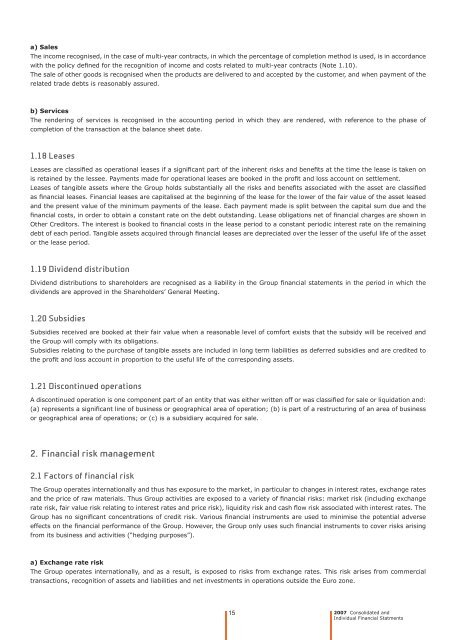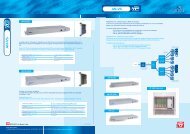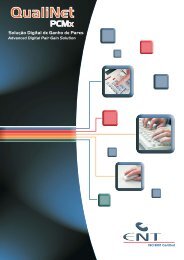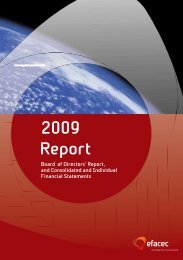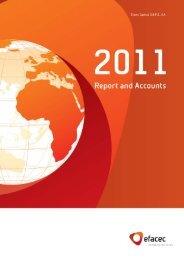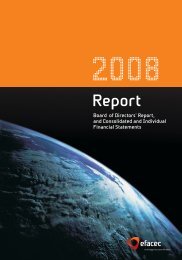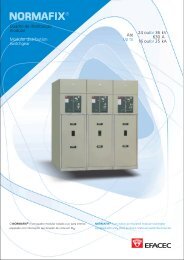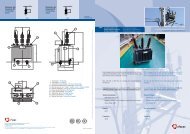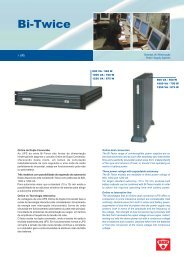Notes to the Financial Statements - Efacec
Notes to the Financial Statements - Efacec
Notes to the Financial Statements - Efacec
You also want an ePaper? Increase the reach of your titles
YUMPU automatically turns print PDFs into web optimized ePapers that Google loves.
a) Sales<br />
The income recognised, in <strong>the</strong> case of multi-year contracts, in which <strong>the</strong> percentage of completion method is used, is in accordance<br />
with <strong>the</strong> policy defi ned for <strong>the</strong> recognition of income and costs related <strong>to</strong> multi-year contracts (Note 1.10).<br />
The sale of o<strong>the</strong>r goods is recognised when <strong>the</strong> products are delivered <strong>to</strong> and accepted by <strong>the</strong> cus<strong>to</strong>mer, and when payment of <strong>the</strong><br />
related trade debts is reasonably assured.<br />
b) Services<br />
The rendering of services is recognised in <strong>the</strong> accounting period in which <strong>the</strong>y are rendered, with reference <strong>to</strong> <strong>the</strong> phase of<br />
completion of <strong>the</strong> transaction at <strong>the</strong> balance sheet date.<br />
1.18 Leases<br />
Leases are classifi ed as operational leases if a signifi cant part of <strong>the</strong> inherent risks and benefi ts at <strong>the</strong> time <strong>the</strong> lease is taken on<br />
is retained by <strong>the</strong> lessee. Payments made for operational leases are booked in <strong>the</strong> profi t and loss account on settlement.<br />
Leases of tangible assets where <strong>the</strong> Group holds substantially all <strong>the</strong> risks and benefi ts associated with <strong>the</strong> asset are classifi ed<br />
as fi nancial leases. <strong>Financial</strong> leases are capitalised at <strong>the</strong> beginning of <strong>the</strong> lease for <strong>the</strong> lower of <strong>the</strong> fair value of <strong>the</strong> asset leased<br />
and <strong>the</strong> present value of <strong>the</strong> minimum payments of <strong>the</strong> lease. Each payment made is split between <strong>the</strong> capital sum due and <strong>the</strong><br />
fi nancial costs, in order <strong>to</strong> obtain a constant rate on <strong>the</strong> debt outstanding. Lease obligations net of fi nancial charges are shown in<br />
O<strong>the</strong>r Credi<strong>to</strong>rs. The interest is booked <strong>to</strong> fi nancial costs in <strong>the</strong> lease period <strong>to</strong> a constant periodic interest rate on <strong>the</strong> remaining<br />
debt of each period. Tangible assets acquired through fi nancial leases are depreciated over <strong>the</strong> lesser of <strong>the</strong> useful life of <strong>the</strong> asset<br />
or <strong>the</strong> lease period.<br />
1.19 Dividend distribution<br />
Dividend distributions <strong>to</strong> shareholders are recognised as a liability in <strong>the</strong> Group fi nancial statements in <strong>the</strong> period in which <strong>the</strong><br />
dividends are approved in <strong>the</strong> Shareholders’ General Meeting.<br />
1.20 Subsidies<br />
Subsidies received are booked at <strong>the</strong>ir fair value when a reasonable level of comfort exists that <strong>the</strong> subsidy will be received and<br />
<strong>the</strong> Group will comply with its obligations.<br />
Subsidies relating <strong>to</strong> <strong>the</strong> purchase of tangible assets are included in long term liabilities as deferred subsidies and are credited <strong>to</strong><br />
<strong>the</strong> profi t and loss account in proportion <strong>to</strong> <strong>the</strong> useful life of <strong>the</strong> corresponding assets.<br />
1.21 Discontinued operations<br />
A discontinued operation is one component part of an entity that was ei<strong>the</strong>r written off or was classifi ed for sale or liquidation and:<br />
(a) represents a signifi cant line of business or geographical area of operation; (b) is part of a restructuring of an area of business<br />
or geographical area of operations; or (c) is a subsidiary acquired for sale.<br />
2. <strong>Financial</strong> risk management<br />
2.1 Fac<strong>to</strong>rs of financial risk<br />
The Group operates internationally and thus has exposure <strong>to</strong> <strong>the</strong> market, in particular <strong>to</strong> changes in interest rates, exchange rates<br />
and <strong>the</strong> price of raw materials. Thus Group activities are exposed <strong>to</strong> a variety of fi nancial risks: market risk (including exchange<br />
rate risk, fair value risk relating <strong>to</strong> interest rates and price risk), liquidity risk and cash fl ow risk associated with interest rates. The<br />
Group has no signifi cant concentrations of credit risk. Various fi nancial instruments are used <strong>to</strong> minimise <strong>the</strong> potential adverse<br />
effects on <strong>the</strong> fi nancial performance of <strong>the</strong> Group. However, <strong>the</strong> Group only uses such fi nancial instruments <strong>to</strong> cover risks arising<br />
from its business and activities (“hedging purposes”).<br />
a) Exchange rate risk<br />
The Group operates internationally, and as a result, is exposed <strong>to</strong> risks from exchange rates. This risk arises from commercial<br />
transactions, recognition of assets and liabilities and net investments in operations outside <strong>the</strong> Euro zone.<br />
15<br />
2007 Consolidated and<br />
Individual <strong>Financial</strong> Statments


